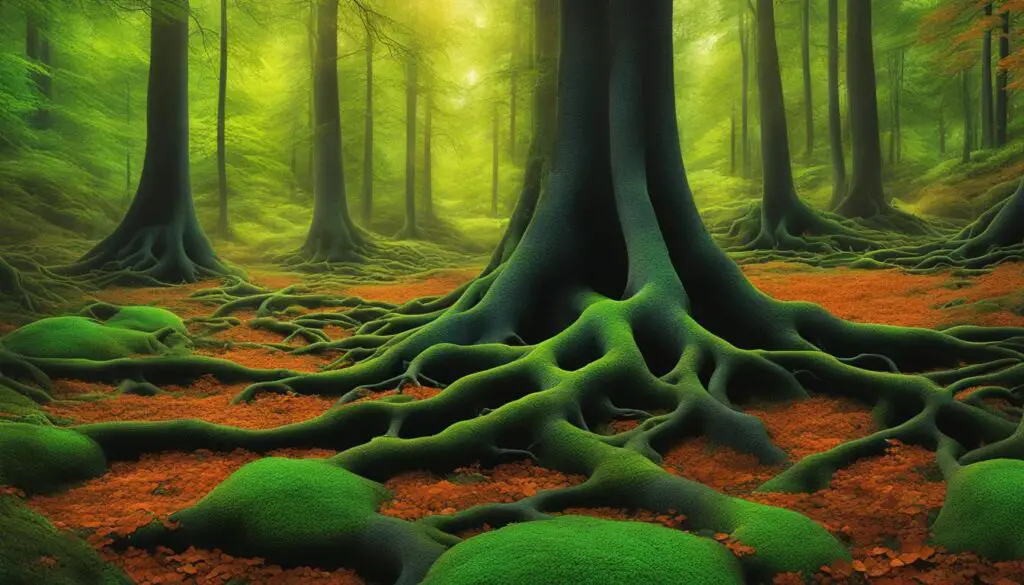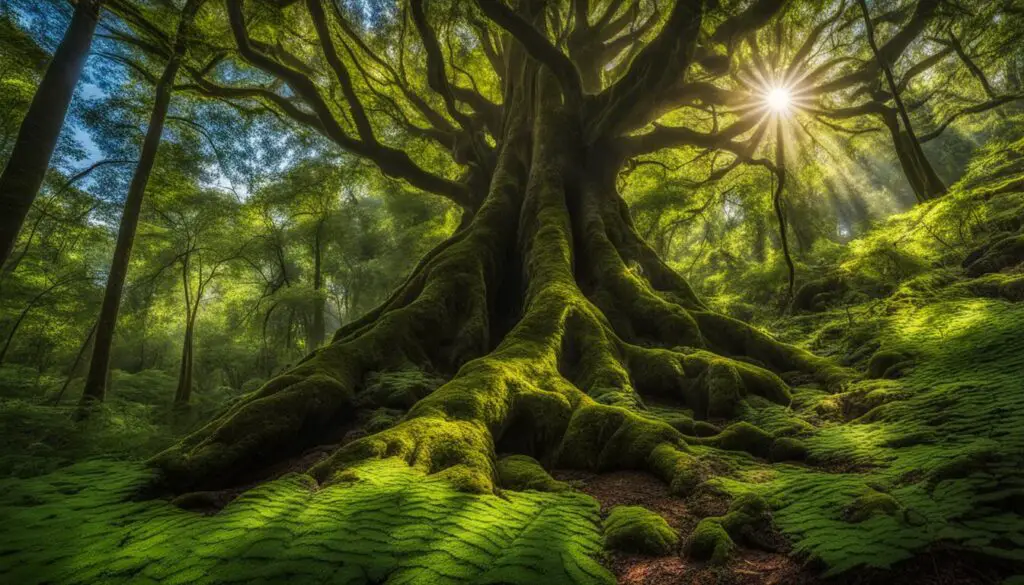Trees are majestic creatures that tower over landscapes and provide numerous benefits to the environment and biodiversity. But have you ever wondered where all that mass comes from? How do trees grow and accumulate such incredible weight? In this article, we will delve into the fascinating world of tree growth and explore the sources of their mass.
Key Takeaways
- Trees accumulate mass through the absorption of nutrients, water, and carbon dioxide, combined with the process of photosynthesis.
- Tree growth factors include available sunlight, adequate water supply, nutrient-rich soil, and optimal temperature conditions.
- Biomass accumulation in trees refers to the total weight of all living and non-living organic materials present in the tree, including roots, leaves, branches, and trunk.
- Trees store carbon in various forms such as sugars, starches, and cellulose, contributing to carbon sequestration and mitigating climate change.
- Tree roots absorb nutrients from the soil, including nitrogen, phosphorus, and potassium, essential for their growth and development.
The Phenomenon of Mast Years: A Burst of Tree Fruit
Every few years, certain tree species undergo mast years, a fascinating phenomenon characterized by an abundance of fruit or nuts. These mast years are not only essential for the survival and reproduction of the trees themselves but also provide a significant food source for wildlife. Let’s explore the intriguing world of mast years and the role they play in tree fruit production.
Mast years occur cyclically, with periods of high production followed by years of lower fruit abundance. During mast years, trees like oaks and beeches release a vast quantity of fruits or nuts, known as mast. This phenomenon is not limited to a single species; other examples include apples, cherries, raspberries, and many more. The specific fruits produced during mast years will depend on the tree species under consideration.
Mast can be further classified into two categories: hard mast and soft mast. Hard mast typically refers to nuts or seeds encased in a hard shell, such as acorns from oak trees or beech nuts. On the other hand, soft mast consists of fleshy fruits like raspberries or blueberries from shrubs and other non-woody plants. These different types of mast provide various food sources for different animals, contributing to their overall diet and survival.
During mast years, the reproductive success of the tree species is greatly enhanced. The increased production of fruit presents an opportunity for efficient seed dispersal, allowing the trees to propagate and establish new populations. By producing an abundance of fruit, trees increase the chances of their seeds being transported and distributed across a wider area, ensuring their genetic diversity and dispersal. Mast years also support the survival and growth of seedlings, as the availability of an ample food source increases their chances of establishing themselves successfully.
The Importance for Wildlife
Mast years have a profound impact on wildlife populations. The abundance of fruit during these years provides a crucial food source for various animals, including rodents, birds, and larger mammals. Small animals like squirrels, mice, and chipmunks heavily rely on mast for their winter storage. The stored mast allows them to survive through periods of scarcity and ensures a stable population size. Additionally, mast years attract a range of bird species, such as jays and woodpeckers, which consume and disperse the seeds, contributing to forest regeneration.
For frugivorous animals, mast years offer an opportunity to thrive and have successful breeding seasons. The abundance of fruit provides the necessary nutrition for breeding, supporting healthy pregnancies and the growth of offspring. Moreover, mast years can have implications for predator-prey dynamics, as the increased availability of food can lead to population fluctuations among both predator and prey species.
In conclusion, mast years are a fascinating natural phenomenon that plays a vital role in tree fruit production, seed dispersal, and ecosystem dynamics. Understanding the cyclical pattern of mast years and their impact on wildlife populations contributes to a broader understanding of forest ecology and the delicate balance of nature.
The Influence of Weather and Communication Among Trees
In the fascinating world of trees, the occurrence of mast years, which is the high abundance of fruit or nuts produced by certain tree species, is influenced by a combination of weather conditions and possible communication mechanisms among trees. These factors play a crucial role in shaping the reproductive success of trees and their interactions with the surrounding ecosystem.
Weather cues, such as spring temperature, summer drought, and spring frost, have a significant impact on mast seeding. During favorable weather conditions, trees are more likely to produce an abundance of seeds or fruits, ensuring the survival of their offspring. These weather cues act as signals, guiding the timing and intensity of mast years in various tree species.
Additionally, researchers have put forth theories about communication among trees that may contribute to synchronized mast years. It is believed that trees can communicate through chemicals and pollen exchange, allowing them to coordinate their reproductive efforts. This chemical and pollen communication network facilitates the synchronization of mast years, ensuring the maximum efficiency of resource allocation and increasing their chances of successful reproduction.
The Cycles of Oak and Beech Trees
Oak and beech trees are emblematic examples of mast-seeding trees, with their mast years occurring approximately every 5-10 years. These cycles have captivated scientists and nature enthusiasts alike, prompting investigations into the underlying mechanisms.
While the precise triggers for these cycles are not yet fully understood, ongoing research suggests that weather cues and communication among trees may play integral roles. The cycles of mast years, combined with the intricate relationships between trees and their environment, highlight the interconnectedness and sophisticated strategies employed by these remarkable organisms.

Image: Weather cues and mast seeding contribute to the occurrence of mast years in trees.
| Tree Species | Typical Mast Year Cycle |
|---|---|
| Oak | Approximately every 5-7 years |
| Beech | Approximately every 8-10 years |
The table above illustrates the typical mast year cycles of oak and beech trees, providing insight into the periodicity of these phenomena. While these cycles may vary depending on environmental conditions, they serve as a general guide to understanding the temporal dynamics of mast seeding in these species.
As our understanding of weather cues and communication mechanisms among trees continues to evolve, we gain deeper insights into the intricate workings of forest ecosystems. Unraveling these mysteries not only enriches our knowledge of the natural world but also underscores the importance of preserving and protecting these invaluable habitats.
The Relationship Between Tree Mass and Tree Survival
Trees have a fascinating strategy to ensure their survival and the continuation of their species. During mast years, which are periods of high fruit and nut production, trees produce an abundance of seeds and nuts. This mass production of reproductive structures serves as an investment in the future, increasing the chances of successful seed germination and the establishment of new trees.
However, the energy expenditure required for trees to produce such mass is significant. Nut production, in particular, demands substantial resources in the form of water, nutrients, and photosynthetic energy. Trees allocate a substantial portion of their energy towards the development and maturation of fruits and nuts, diverting resources away from other physiological processes.
This allocation of energy towards reproduction during mast years not only ensures the survival of future generations of trees but also serves as a form of population control among frugivores. Frugivores, such as birds and mammals, rely on tree fruits and nuts as a food source. During mast years, frugivores experience a bounty of food, leading to population growth.
However, not all of the produced seeds and nuts will be consumed by frugivores. Some will fall to the ground or remain uneaten, ensuring a proportion of the mass produced by trees goes unharvested. This natural surplus helps sustain tree populations in non-mast years when the availability of fruits and nuts is limited.
The unharvested seeds and nuts present an opportunity for the survival and establishment of new trees. These untouched resources provide the next generation of trees with the chance to grow and develop without the competition posed by excessive frugivore consumption.
This relationship between tree mass production and survival highlights the intricate ecological balance that mast years create. It demonstrates how trees strategically invest their energy towards reproduction, ensuring their survival while also controlling frugivore populations and promoting the establishment of new trees in subsequent years.
Unlocking the Secrets of Tree Rings and Solar Activity
Tree rings hold invaluable insights into the history of solar activity and longer-term cycles. By analyzing the concentrations of radioactive carbon (C14) in tree rings, scientists have reconstructed the Schwabe cycle, an 11-year cycle of solar activity. These concentrations, influenced by cosmic rays, provide a gauge for the intensity of solar activity. Through meticulous examination of tree-ring archives, researchers have successfully reconstructed solar activity spanning over the last millennium.

Reconstructing solar cycles through tree rings involves careful analysis and interpretation. The study of cosmic rays and radionuclides, along with the examination of tree-ring records, allows scientists to deduce the ebb and flow of solar activity throughout history. This fascinating field of research provides valuable insights into the complex relationship between trees and their solar environment.
The Impact of Trees on Climate and Rainfall
Forests play a crucial role in regulating the climate and influencing rainfall patterns. Their immense impact on the environment extends beyond providing oxygen and habitat for wildlife. The cooling effect of forests and their ability to contribute to rain cloud formation make them essential in maintaining ecological balance.
Satellite data has revealed that forests have a significant cooling effect on the surrounding landscape, especially on scorching summer days. In fact, they can lower temperatures by up to 20 degrees Fahrenheit. This cooling effect is attributed to the shade provided by the forest canopy and the process of evapotranspiration.
Through transpiration, trees release moisture into the atmosphere. This moisture then combines with other atmospheric factors to contribute to the formation of rain clouds. Forests act as natural humidifiers, increasing the chances of precipitation in their vicinity.
The presence of forests creates a microclimate that supports rainfall and helps regulate temperature. The dense vegetation in forests intercepts rainfall, facilitates water infiltration, and reduces soil erosion. This intricate relationship between forests and precipitation is vital for sustaining ecosystems, agriculture, and the overall well-being of our planet.
The Hidden Life of Trees: Social Bonds and Communication
Trees are not solitary individuals but rather part of a complex social network. They live in communities and form deep-rooted connections with one another. In fact, trees have families, with parent trees nurturing and supporting their offspring. This sociality of trees is not limited to above-ground interactions, but it extends below the surface, where communication happens through root systems and fungi networks.
Through their intricate root systems, trees exchange vital nutrients, water, and even chemical signals. It is through these connections that trees can support and share resources with needy or sick individuals within their community. This mutual aid and cooperation ensure the overall well-being and survival of the forest ecosystem.
But the communication among trees goes beyond simple resource sharing. Recent research has revealed that trees can warn each other of impending dangers. When under attack by insects or pests, trees release chemicals into the air as a signal to neighboring trees, preparing them to defend against the threat. This collective defense mechanism strengthens the resilience of the entire forest.

The hidden life of trees is truly remarkable, filled with intricate social bonds and intricate communication networks. Understanding the sociality of trees and their interconnectedness sheds new light on the fascinating world that exists beneath the forest floor.
The Sensory World of Trees: Seeing, Smelling, Tasting, Feeling, and Hearing
Trees are not only silent observers of their surroundings but also active participants in their environment. They possess an array of sensory capabilities that enable them to detect and respond to various stimuli. Let’s dive into the fascinating sensory world of trees and discover how they perceive and interact with the world around them.
Seeing and Recognizing
Trees have an incredible ability to “see” and recognize their own species or plant family members. Through their specialized cells and receptors, trees can distinguish between different wavelengths of light and determine if the shade or sunlight they receive is from their own kind or a neighboring species.
Communication Through Smell and Taste
Smell plays a crucial role in tree communication. Trees release volatile compounds, such as terpenes and phenols, that act as chemical signals to neighboring trees. These scents carry important information about potential threats, such as insect attacks or herbivore feeding, and can trigger defense responses in nearby trees.
Just as the aroma of freshly baked cookies can beckon you from a distance, trees use their distinct smells to communicate with one another, building a network of olfactory signals.
Intriguingly, trees can also taste the saliva of animals feeding on their leaves or branches. When animals consume parts of a tree, they leave behind a unique blend of chemicals in their saliva. The tree detects these substances and can respond in specific ways, such as producing toxic compounds to deter further feeding or increasing the production of defensive chemicals.
Feeling and Responding to Touch
Trees have a sensitive side too! They can feel and respond to touch, especially when they are under attack by pests or pathogens. When a tree is wounded or has pests crawling on its surface, it triggers a response that involves the production of defensive compounds, such as resins or gums, to protect itself from further harm.
Hearing and Perceiving Sound Vibrations
While trees may not have ears like humans do, they can still perceive sound vibrations. Research suggests that trees can sense vibrations generated by wind, insect movement, or even human activities. These vibrations can elicit responses in trees, such as changes in leaf movement or altering their growth patterns.
The sensory capabilities of trees allow them to be in tune with their environment, enabling them to react and adapt to changes in their surroundings. The ability to see, smell, taste, feel, and even hear allows trees to communicate, defend themselves, and thrive in their ecosystems.
Old Trees and Forest Ecosystems
Old trees have a critical role in the health and sustainability of forest ecosystems. These ancient giants act as mother trees, providing support and nurturing to younger trees. Through their extensive root systems, old trees share nutrients, water, and even information with their neighboring trees. This interconnected network fosters the growth and resilience of the entire forest.
Thinning forests, however, can disrupt these family bonds and have a significant impact on biodiversity. When old trees are removed, the loss of their guidance and support can hinder the growth of younger trees and disrupt the delicate balance of the ecosystem. This disruption can lead to the decline of certain species and a loss of overall biodiversity.
On the other hand, in unmanaged forests where old trees thrive, the benefits of their presence are evident. These forests exhibit greater biodiversity and have a higher capacity for resilience in the face of disturbances such as climate change and pests. The longevity and stability of old trees contribute to the overall health and functioning of the forest ecosystem.

In addition to supporting younger trees, old trees provide a habitat for a wide range of species, including insects, birds, and mammals. Cavities in their trunks and branches offer shelter and nesting sites for many wildlife species. The decaying wood of old trees also becomes a valuable resource for decomposers, facilitating nutrient cycling and contributing to the overall fertility of the forest.
An intact forest ecosystem with a healthy population of old trees is essential for maintaining biodiversity and protecting the natural balance of our planet. Forest management practices should prioritize the conservation of old trees and the preservation of unmanaged forest areas where these ancient giants can thrive.
The Role of Old Trees in Unmanaged Forests
Unmanaged forests, characterized by the presence of old trees, have been shown to support greater biodiversity and ecological resilience compared to managed forests. These unaltered ecosystems provide unique habitats for a wide range of species and contribute to the overall balance of nature.
| Benefits of Old Trees in Unmanaged Forests | Managed Forests | Unmanaged Forests |
|---|---|---|
| Biodiversity | Reduced diversity due to limited habitat complexity and removal of old trees | Higher species diversity due to varied habitats and presence of old trees |
| Resilience | Less resilient to disturbances such as climate change and pests | Greater resilience to environmental changes and disturbances |
| Nutrient Cycling | Reduced nutrient cycling due to limited decay processes | Enhanced nutrient cycling through decaying wood and extensive root systems |
By preserving unmanaged forests and recognizing the value of old trees, we can conserve biodiversity, support ecological resilience, and ensure the long-term health of our forests. It is essential to strike a balance between forest management practices and the preservation of unmanaged areas to maintain the intricate web of life that depends on old trees and forest ecosystems.
The Impact of Tree Management Practices
The debate on forest management practices has been an ongoing topic of discussion in environmental circles. Traditional approaches often involve thinning trees and replanting as a means to maintain the health and productivity of forests. However, alternative approaches have emerged that emphasize the importance of unmanaged forests and environmentally friendly practices.
Alternative approaches to tree management prioritize the preservation of old trees, natural regeneration, and the protection of forest ecosystems. Proponents argue that unmanaged forests are more resilient, maintain greater biodiversity, and have a lower environmental impact.
Table: Comparing Traditional and Alternative Tree Management Approaches
| Traditional Tree Management | Alternative Tree Management |
|---|---|
| Involves thinning trees and replanting | Emphasizes the preservation of old trees |
| Focuses on maximizing productivity | Prioritizes forest ecosystem preservation |
| May require the use of chemicals and machinery | Fosters natural regeneration and minimal intervention |
| May disrupt natural forest dynamics | Maintains forest resilience and biodiversity |
By implementing environmentally friendly forest practices, it is possible to strike a balance between human needs and the long-term health of our ecosystems. These practices can ensure the sustainability of forests while minimizing negative impacts on biodiversity and the environment as a whole.
The Success of “The Hidden Life of Trees” and Peter Wohlleben’s Forest Academy
Peter Wohlleben’s book, “The Hidden Life of Trees,” has become an international sensation, captivating readers around the world. Translated into multiple languages, this book explores the social bonds and communication that exist among trees. The public’s fascination with the hidden world of trees has contributed to the overwhelming success of this book.
Inspired by the success of “The Hidden Life of Trees,” Peter Wohlleben has taken his passion for tree conservation to the next level by establishing his own forest academy. Through his academy, he aims to promote tree conservation and raise awareness about the vital role that forests play in our ecosystem.
With his extensive knowledge and expertise, Peter Wohlleben continues to inspire others to appreciate and protect trees. His work serves as a call to action, encouraging individuals to make a difference in the conservation of our natural world.

Through his book and forest academy, Peter Wohlleben is instrumental in promoting tree conservation and raising awareness about the profound interconnectedness of trees. By revealing the hidden life of trees, he encourages us to recognize and appreciate their importance in our lives and the planet as a whole.
Conclusion
The accumulation of mass in trees is a fascinating process that involves the absorption of nutrients, water, and carbon dioxide, as well as the conversion of these resources into stored sugars and carbohydrates through photosynthesis. However, trees are not solitary beings; they communicate and support each other through intricate social bonds and complex network systems.
Understanding the mechanisms of tree communication and mass accumulation is crucial for the conservation of our forests and the preservation of our natural ecosystems. Forest conservation efforts play a vital role in mitigating the environmental impact of deforestation and promoting the sustainability of our planet.
By protecting and nurturing our forests, we can ensure the continued existence of these remarkable organisms and their invaluable contributions to our planet. Tree mass accumulation and communication are interconnected processes that sustain the delicate balance of our ecosystems. Let us embrace the importance of forest conservation and work together to safeguard the future of our forests and the environment as a whole.
FAQ
Where do trees get their mass?
Trees accumulate mass from the nutrients and water absorbed by their roots, the carbon dioxide they take in during photosynthesis, and the stored sugars and carbohydrates they produce.
What are mast years?
Mast years are years when certain tree species produce a high abundance of fruit or nuts. They play a critical role in the reproductive success of trees and provide a significant food source for animals.
What influences mast years in trees?
Mast seeding in trees is influenced by weather conditions such as spring temperature, summer drought, and spring frost. There are also theories that trees may communicate via chemicals or pollen exchange to synchronize their mast years.
How do tree mass and survival relate?
Trees produce an abundance of nuts and fruits during mast years as a strategy to ensure the survival of future generations. This leads to an increase in tree survival rates and population control among frugivores.
What can tree rings reveal about solar activity?
Tree rings can provide valuable information about solar activity. Scientists have been able to reconstruct the Schwabe cycle, an 11-year cycle of solar activity, by analyzing the concentrations of radioactive carbon (C14) in tree rings.
How do forests impact climate and rainfall?
Forests have a cooling effect on the surrounding landscape and can contribute to the formation of rain clouds. Trees release moisture through transpiration, which can support rainfall and help regulate temperature.
Do trees have social bonds and communication systems?
Yes, trees have complex social bonds and communication systems. They live in communities, support their offspring, communicate through root systems and fungi networks, and share nutrients with each other.
What sensory capabilities do trees possess?
Trees have the ability to “see” and recognize their own species or plant family members. They can also communicate through smell, taste, touch, and even perceive sound vibrations.
What is the role of old trees in forest ecosystems?
Old trees serve as mother trees that support and nurture younger trees. They contribute to greater biodiversity and resilience in unmanaged forests, promoting overall ecosystem health.
What is the impact of tree management practices?
The impact of tree management practices is a subject of debate. Traditional practices involve thinning trees and replanting, while alternative approaches prioritize the preservation of old trees, natural regeneration, and the protection of forest ecosystems.
What is the success of “The Hidden Life of Trees” and Peter Wohlleben’s Forest Academy?
“The Hidden Life of Trees” by Peter Wohlleben has achieved worldwide success and inspired others to appreciate and protect trees. Peter Wohlleben has started his own forest academy to promote tree conservation and raise awareness about the importance of forests.
What is the secret behind where trees get their mass?
Trees get their mass from absorbing nutrients, water, and carbon dioxide, and converting them into stored sugars and carbohydrates through photosynthesis. Understanding these processes and promoting forest conservation is crucial for preserving the health and sustainability of ecosystems.

